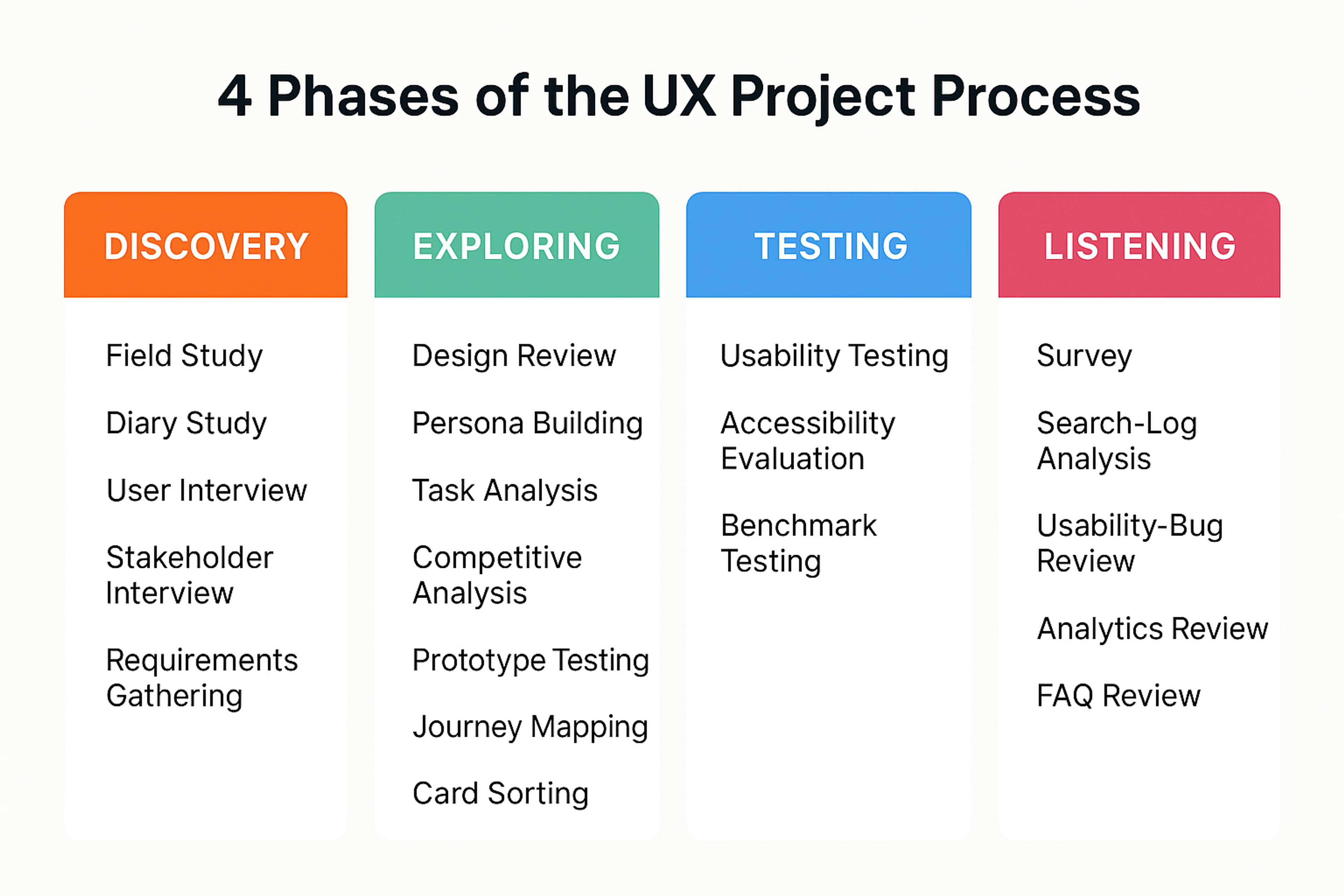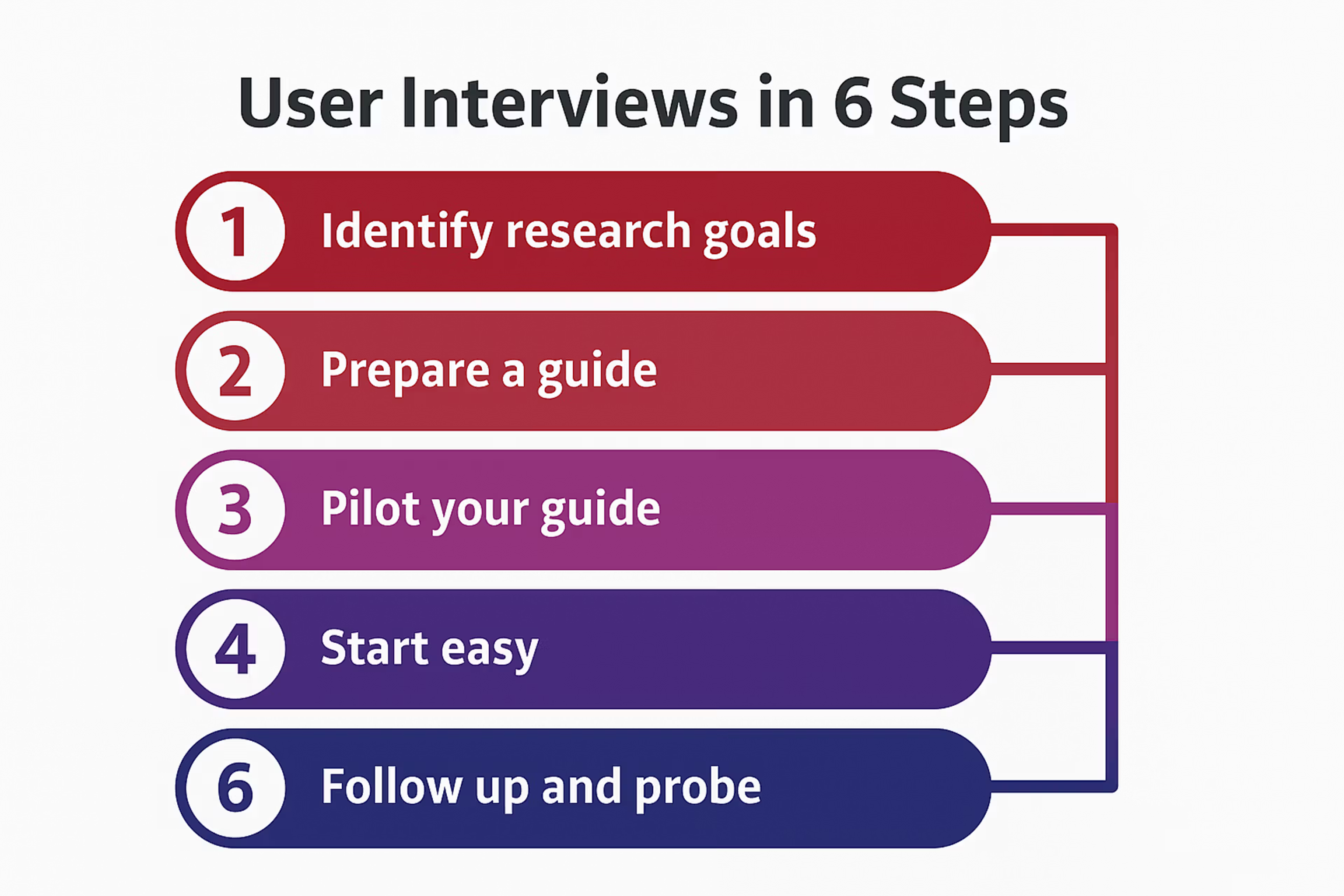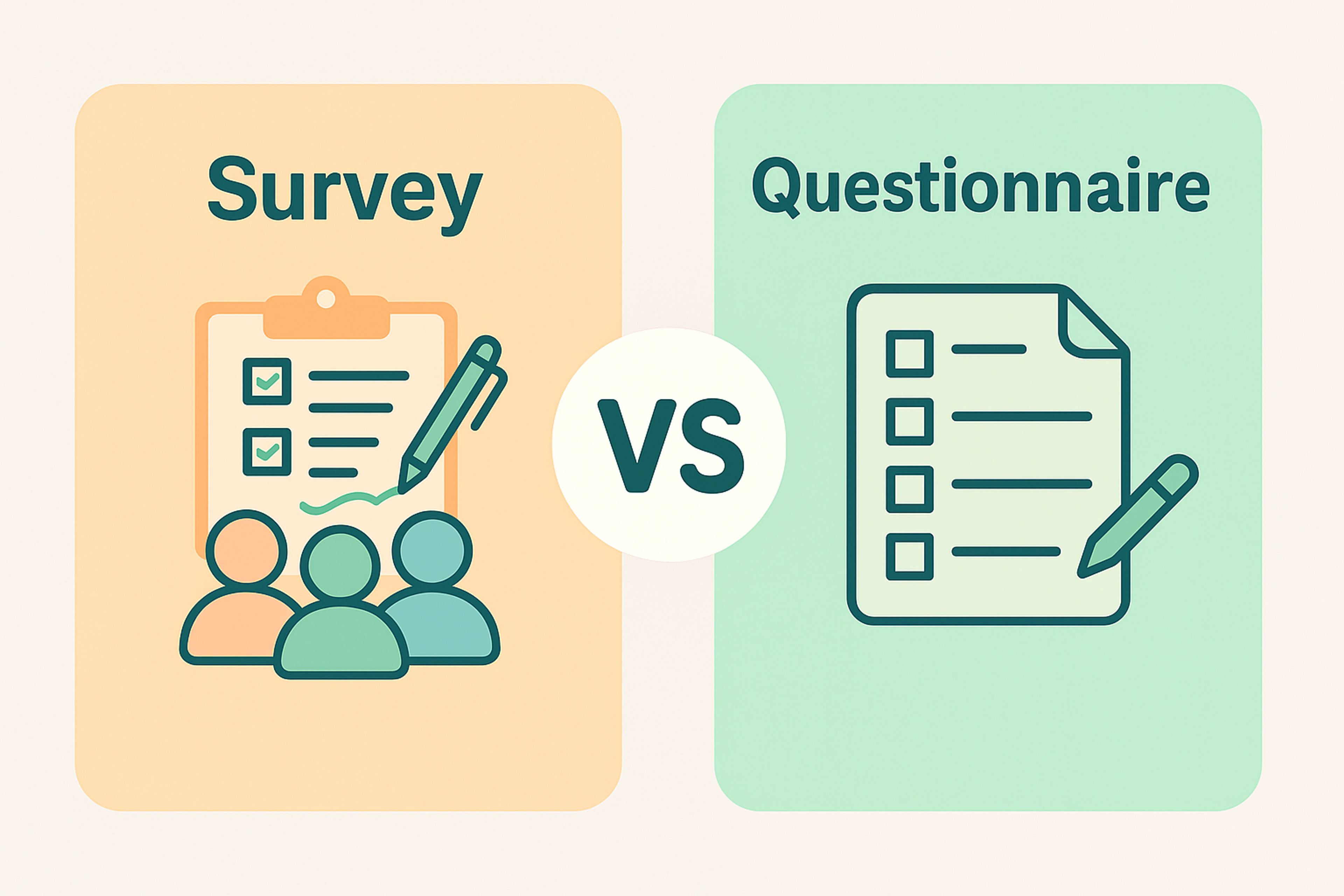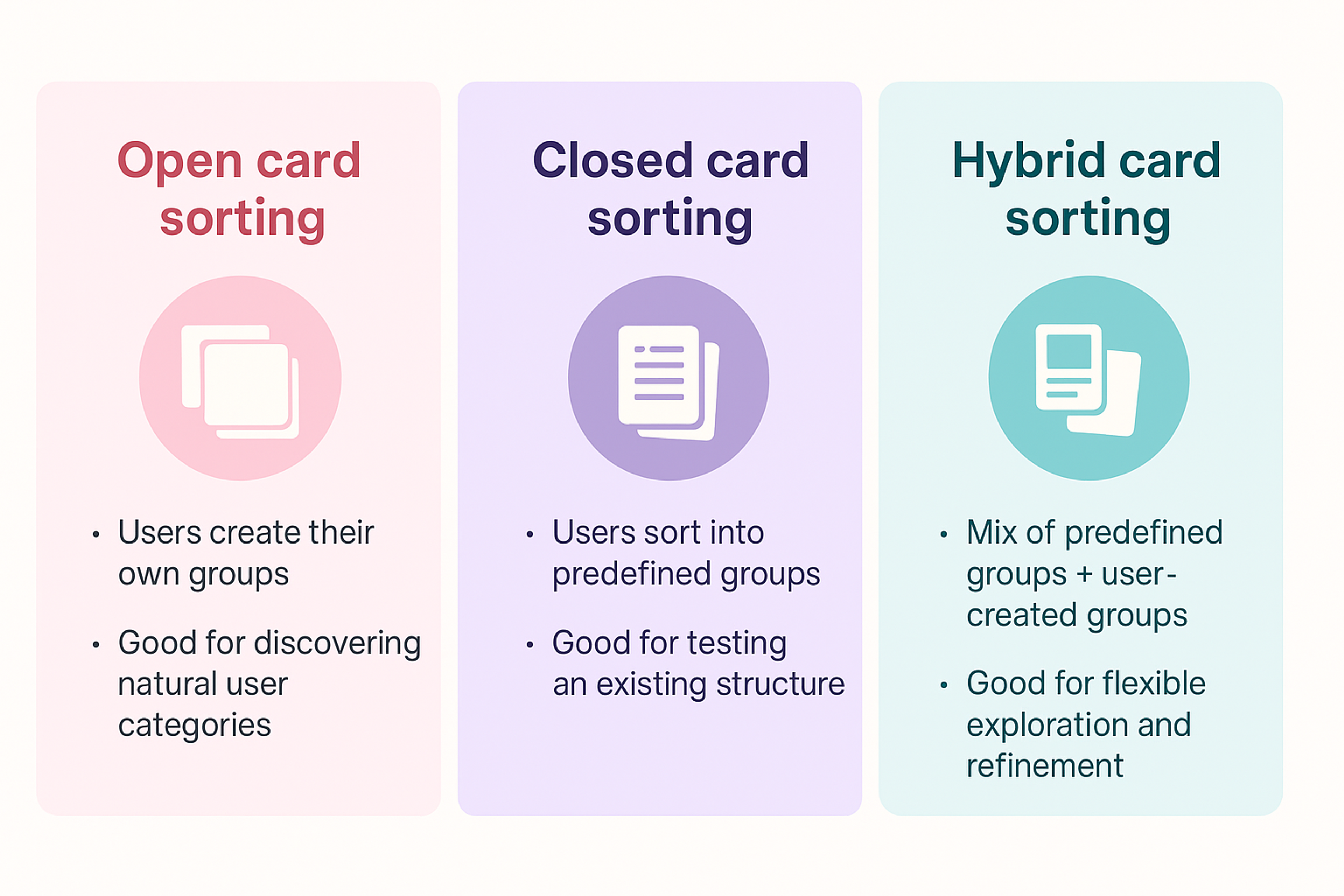If you want people to love your product, you have to understand them first. That’s what user experience (UX) research helps you do. It shows what your users need, what they expect, and what really matters to them.
When you do research with clear goals, you get better results. You learn how real people think, feel, and act when using your product. This helps you make smarter choices, solve the right problems, and avoid guesswork.
This guide will walk you through each step of the user research methodology. It will help you start your project with a clear plan and a better understanding of your users.
Key Takeaways
User research helps teams design better products by deeply understanding user needs and behaviors. Here are the key takeaways:
- Drives user research by aligning features with real behaviors, goals, and expectations.
- Follows a structured process — discovery, exploration, testing, and listening — to guide decisions.
- Reveals friction points early, allowing for proactive design improvements.
- Uses mixed methods like interviews, surveys, and card sorting to gather rich insights.
- Ensures continuous refinement through feedback loops and post-launch evaluation.
- Supports user research by replacing assumptions with real user data.
User research leads to smarter design choices, stronger user satisfaction, and a clear competitive advantage.
What Is the UX Research Process?
The UX research process helps product teams understand what users need, do, and expect. Researchers use different methods to spot problems and find gaps in the market. These insights help teams build products that stand out.
UX Research Process by Clay

User research follows a clear and organized plan. It includes studies designed to learn how people think and act when using an app or service. Many teams watch real users interact with their product to see what works and what doesn’t. This helps them improve the design and create a better user experience.
Why Is an Effective User Research Process Crucial?
The accuracy of the user research process is crucial in determining successful product design. Capturing users’ needs, behaviors, and motivations defines how productive a solution will be.
The research exposes the critical factors needed to create compelling and smooth user experiences, enhancing satisfaction and retention. Evaluating and effectively communicating research findings ensures that insights are organized and shared across all departments, fostering better collaboration and product storytelling.
Other than making a product easier to use, user research enables teams to identify potential obstacles and pain points well in advance so that they can design proactively. In addition, it transforms the organization’s psychology by creating a customer-driven culture where decisions are made based on real users’ experiences instead of a priori reasoning.
Ultimately, user research is not solely about perfecting a product. Instead, it is about creating a vigorous yet passive experience that is, more than anything else, a market differentiator.
What Are the 4 Phases of the UX Project Process?
The phases of user research are largely divided into four major categories: Discovery, Exploration, Testing, and Listening. Each stage has a strong and impactful purpose in the fundamental building and shaping of a user-centered product.
Integrating user research methodology throughout the design process allows designers to validate their assumptions and continuously refine their approach as they progress through different phases of product development.
4 Phases of the UX Research Process

Discovery
As an initial step, the discovery phase conducts user research to tailor the research project to specific goals and available resources, acquiring information regarding user behaviors and eventual contexts wherein the product is expected to be utilized. This phase identifies an area of the knowledge gap and offers possible options for follow-up research.
These techniques include field studies, stakeholder and user interviews, diary studies, requirements gathering, etc. All these approaches enable teams to capture useful findings to prepare for the subsequent phases.
Exploration
In this phase of the project, teams must attempt to comprehend the problems a user is facing and how to stage the design work. This portion of work is significant for idea development and evaluating the early design ideas.
Understanding user problems often requires gathering qualitative data through user interviews and various user research methods. Qualitative data can unveil the deeper reasons behind user behavior and attitudes, providing valuable insights.
Competitive analysis, persona development, journey mapping, task analysis, and Idea walkthroughs are examples of how teams could streamline thought processes before heading into development stages. You’d be amazed at what these techniques can do.
Usability Testing
The goal of the evaluation phase is to confirm the design is functional, user-friendly, and robust enough to accommodate various users. Currently, teams implement usability studies, benchmark testing, and accessibility designs to audit the system’s usability. In essence, this process reveals the pain points and ensures that these are solved most simply from a user’s perspective before the launch happens.
Additionally, incorporating focus groups as a qualitative research method can provide valuable insights from a small group of participants about their beliefs and opinions, particularly for market research purposes. This helps in gaining a comprehensive understanding of user behavior and attitudes, ensuring well-rounded data collection.
Listening
This phase involves gaining knowledge from users themselves after the product has been released. Evaluation is useful for determining how successfully the product solves user problems and where further improvements might be possible.
Consulting with a research team can greatly influence the selection of appropriate research methods based on project goals, phase of research, and available resources, thereby enhancing the quality of insights gathered throughout the design process.
Common techniques include surveys, product analytics, search-log analysis, and usability-bug reviews. Listening on a continuous basis enables teams to make fast-paced changes to meet expectations.
Even the most simplistic segmentation of the UX research stages reveals that they are capable of assisting teams in developing products that seek to serve the user in real-life situations.
Mastering the UX Research Process: A Step-by-Step Guide
Understanding user behavior and pain points is key to making design decisions. What is less understood is the multifaceted design strategies that can be employed with UX research. UX research relies heavily on understanding underlying user needs and using a set structure instead of a random guesswork approach.
The six core steps for conducting effective UX research are outlined below. Choosing the most suitable UX research method is crucial, as it depends on factors such as the project stage, goals, and available resources.
User Research Methods by Clay

1. Define Your Research Goals
Like any meaningful undertaking, effective research begins with clarifying the broad problem to be solved. What needs to be achieved at the end of the project? Having defined objectives helps keep the researcher focused on efficient outcomes.
UX research requires businesses to define explicit objectives for the problems they want to solve for their customers. Having well-established questions is a prerequisite for every successful goal. There must be measurable outcomes, whether intended as usability problems, behavioral understanding, or pain points. Defining the main research questions is equally essential.
Intervention and support from stakeholders are equally crucial at this stage. Demonstrating research goals helps secure the right stakeholders, which are critical to capturing resources and accepting changes to be made post-research.
2. Develop a Research Plan
Finding the right research strategy comes next after establishing the project goals. Different approaches provide different insights and can be more or less valuable based on the end goal. Standard UX research methods are surveys, user interviews, and usability testing.
While the first two provide broad quantitative data and rich qualitative insights, usability testing helps directly observe interactions with a product. A/B testing for version comparisons and field studies where researchers observe users in their environment is also beneficial.
Recruitment selection is equally important as method selection. Having a varied mix of users greatly enhances the research's representativeness. Despite the importance of having a varied participant sample, having representative research materials like interview guides, test scenarios, and mockups cannot be overlooked.
3. Conduct the Research
Now that a plan is in place, conducting research begins with defining clear goals to ensure the process is effective. This phase involves conducting surveys, usability tests, interviews, and field studies to assess user experience.
UX Research Process

Researchers should watch how users engage with the construct, documenting the processes (with the users’ consent) for more in-depth analysis. Qualitative and quantitative data mixes always capture the user’s needs from every angle.
Attention to friction points - in other words, the aspects of a project that users may find difficult, puzzling, or that cause them to disengage - must be on another level. Folding these insights into a design will bring targeted improvements immediately.
4. Analyze Data & Extract Key Insights
Making sense of raw information requires various steps, one of which is sorting it to bring practical insights. Fundamental issues of concern and usefulness, extreme user pain points, and suggestions to improve user satisfaction and engagement are classified as themes that help make fusion work efficiently.
At this point, creating a user persona can also be beneficial. They represent different users grouped into one, which helps the team understand how each user will respond and interact with the project.
Reviewing the perception gap will answer the difficulties disenfranchised users suffer as valuable measures of eliminating areas of concern and streamlining user interaction with systems.
Passing on essential information to teams improves user experience. It shouldn't be delayed, so share insights with designers, developers, and stakeholders who need to adjust for structural solutions to functional problems.
5. Implement Insights into Design
Putting insight into good use will improve the delivery of different results that can be achieved with other approaches. Most painful and frequent usability troubles should be resolved first, so prioritizing the rest and issue severities next to avoid complicating usability isn't ideal.
Refining an application's navigation system and interface elements is one of the standard design changes made after conducting UX Research. Personalization, which is driven by onboarding survey data, can also improve engagement by making the experience feel more customized.
Prototypes need to go through active testing with feedback loops. All enhancements should be validated before deployment, but iteration must always be ensured.
6. Evaluate & Iterate for Continuous Improvement
UX research is a continued process. Measuring changes' effectiveness ensures that real usability improvements have been made. Monitoring user behavior through analytics, usability tests, and gathering feedback after product launch helps further enhance the product.
Updates are essential due to the flux in user expectations and behavior. Regular testing and updates keep a product user-friendly and aligned with customer and market needs. Keeping this cycle of analysis and research helps us meet User Experience goals.
UX Research Examples
Here are some best UX research examples.
User Interviews
User interviews provide deep insights into user needs, frustrations, and behaviors that surveys often miss. For example, a recruiter’s struggle with a time-consuming hiring process highlighted the need for a more efficient system — insights like these drive better product decisions.
6 Steps for Conducting a User Interview

How User Interviews Improve UX
Direct conversations reveal hidden pain points and motivations, allowing designers to refine user experiences based on real-world feedback. Asking follow-up questions uncovers details that data alone can’t provide, leading to smarter, user-centered solutions.
Planning Effective Interviews
A clear objective, the right participants, and an open yet structured format ensure meaningful responses. Creating a comfortable environment encourages honesty, making interviews a powerful tool for shaping better, more intuitive UX designs.
Surveys and Questionnaires
Surveys and questionnaires are essential for gathering user insights, offering both quantitative and qualitative data to guide design decisions. To use them effectively:
- Set clear objectives: Define whether you’re measuring satisfaction or testing a feature.
- Craft thoughtful questions: Use a mix of closed-ended for trends and open-ended for deeper insights.
- Distribute strategically: Reach users via email, social media, or in-app prompts.
- Analyze results: Identify patterns to inform product improvements.
Survey vs Questionnaire

Using Surveys for UX Data
Surveys provide measurable feedback, helping teams refine usability and user satisfaction. For example, asking users to rate a new feature highlights areas needing improvement, ensuring data-driven enhancements.
Writing Effective UX Questions
The key to useful insights is well-structured questions. Targeting the right users ensures relevance, while open-ended prompts encourage meaningful responses. Thoughtful survey design leads to richer insights and better UX decisions.
Card Sorting
Card sorting is a powerful UX research method that helps designers structure content based on user perception.
By having participants group related items, researchers gain insights into how people mentally categorize information, shaping more intuitive navigation for websites and apps.
Sessions can be conducted physically or online, and analyzing patterns afterward ensures a seamless and user-friendly experience.
Open, Closed & Hybrid Cardsorting

How Card Sorting Improves UX
Card sorting helps define navigation structures and content hierarchies. Open card sorting lets users create their own categories, revealing natural thought patterns, while closed card sorting tests predefined structures. Both methods refine information architecture, improving usability and efficiency.
Practical Applications
Card sorting is essential for website redesigns and app development, ensuring content is logically structured. E-commerce platforms use it to optimize product navigation, while apps refine feature organization based on user input. By applying card sorting insights, designers create intuitive, user-centered experiences that enhance engagement and usability.
UX Research Frameworks
A UX research framework is a structured approach that organizes methods and tools to understand users and their needs, ensuring efficient and insightful research.
Why Is Having a UX Research Framework Beneficial?
A UX research framework ensures a structured, efficient, and consistent approach to gathering user insights. It helps researchers identify needs, streamline processes, and make data-driven design decisions, leading to better user experiences and product success.
Source: Photo by krakenimages on Unsplash

Best Practices for Creating a Perfect UX Research Framework
To create an effective UX research framework, define clear goals, choose the right methods, and ensure a structured approach. Involve stakeholders, prioritize user needs, and maintain flexibility for evolving insights. Use both qualitative and quantitative data to make informed design decisions.
What Components to Include in a UX Research Framework?
A UX research framework should include clear objectives, research methods, user personas, data collection tools, and analysis strategies. It must also outline stakeholder involvement, usability testing, and feedback loops to ensure continuous improvement.
FAQ
Q: How Does UX Research Differ from Market Research?
UX research focuses on how users interact with a product to improve usability, while market research explores customer demographics, preferences, and purchasing behavior to guide business strategy.
Q: Who Should Be Involved in a UX Research Project?
UX researchers, designers, product managers, and key stakeholders should be involved to ensure insights are actionable and aligned with both user needs and business objectives.
Q: How Long Does a Typical UX Research Cycle Take?
A UX research cycle can take anywhere from a few days to several weeks, depending on the research method, scope, and depth of insights required.
Q: Can UX Research Be Conducted Remotely?
Yes, UX research can be done remotely using digital tools for interviews, usability testing, surveys, and analytics, offering flexibility and broader user reach.
Q: How Do you Choose the Right UX Research Method?
Choose a UX research method based on your goals, timeline, and product stage — qualitative methods for deep insights, and quantitative methods for broader patterns.
Read more
Conclusion
As we've seen, user-centric design starts with UX research. It captures insights, sets goals, and receives feedback from real users so that it can make decisions on usability. Because users' needs will continually change over time, capturing these insights through UX Research will continuously boost user satisfaction while giving the business a competitive edge.


About Clay
Clay is a UI/UX design & branding agency in San Francisco. We team up with startups and leading brands to create transformative digital experience. Clients: Facebook, Slack, Google, Amazon, Credit Karma, Zenefits, etc.
Learn more

About Clay
Clay is a UI/UX design & branding agency in San Francisco. We team up with startups and leading brands to create transformative digital experience. Clients: Facebook, Slack, Google, Amazon, Credit Karma, Zenefits, etc.
Learn more


